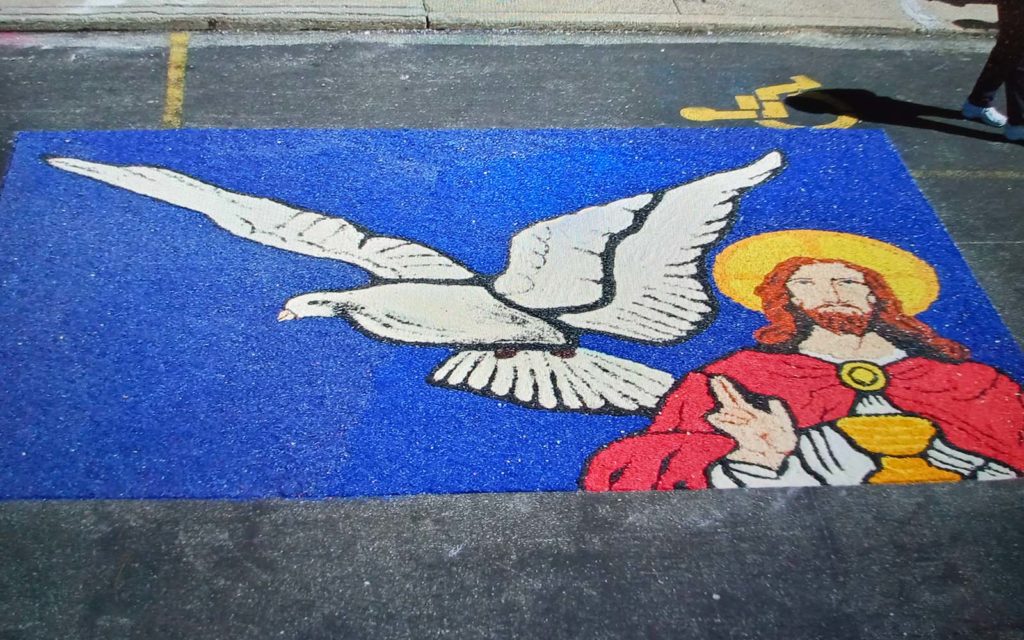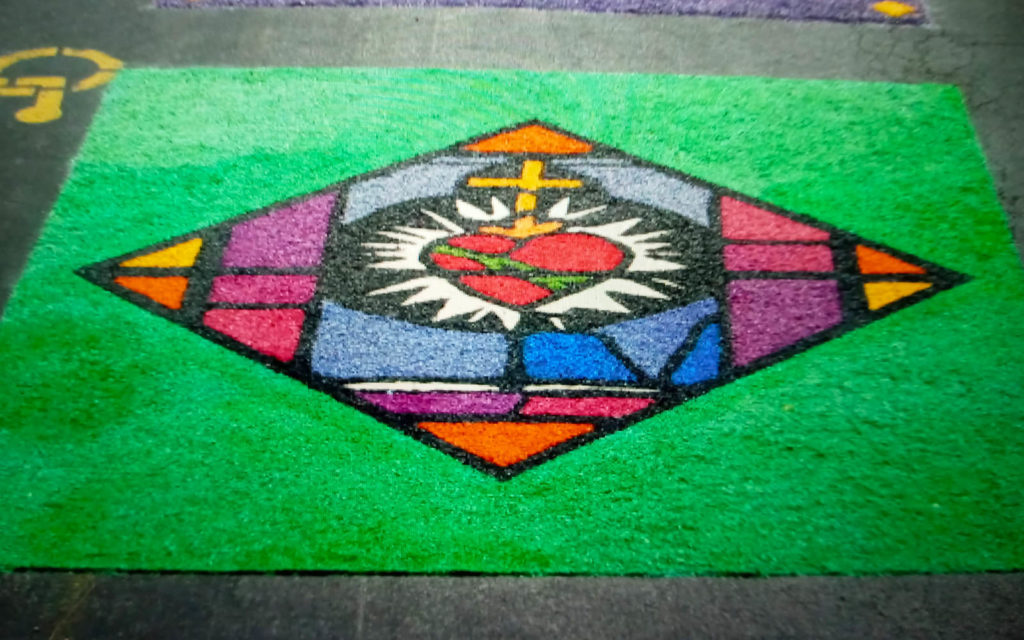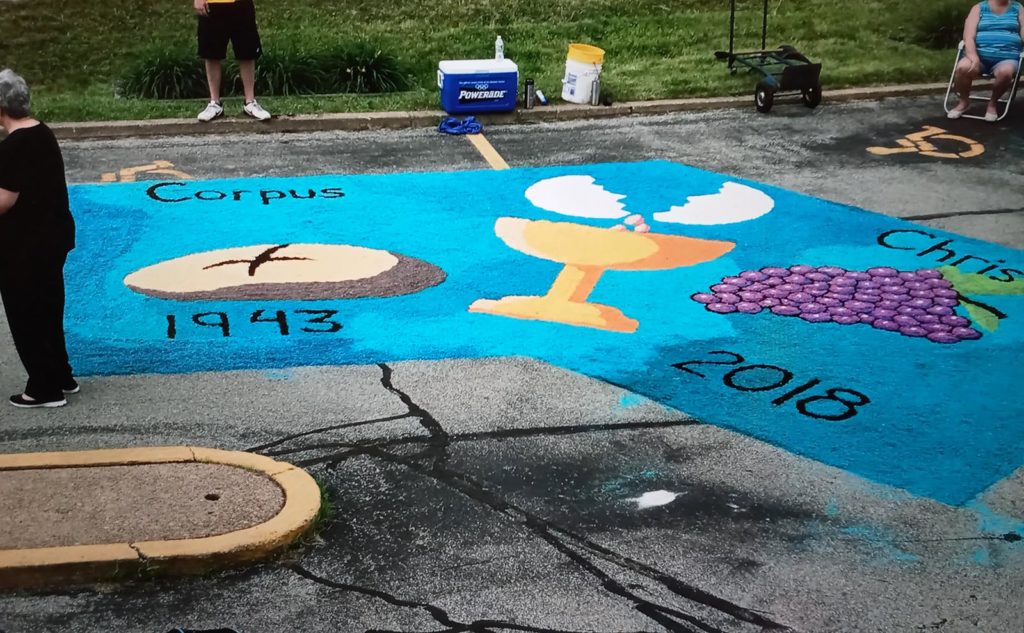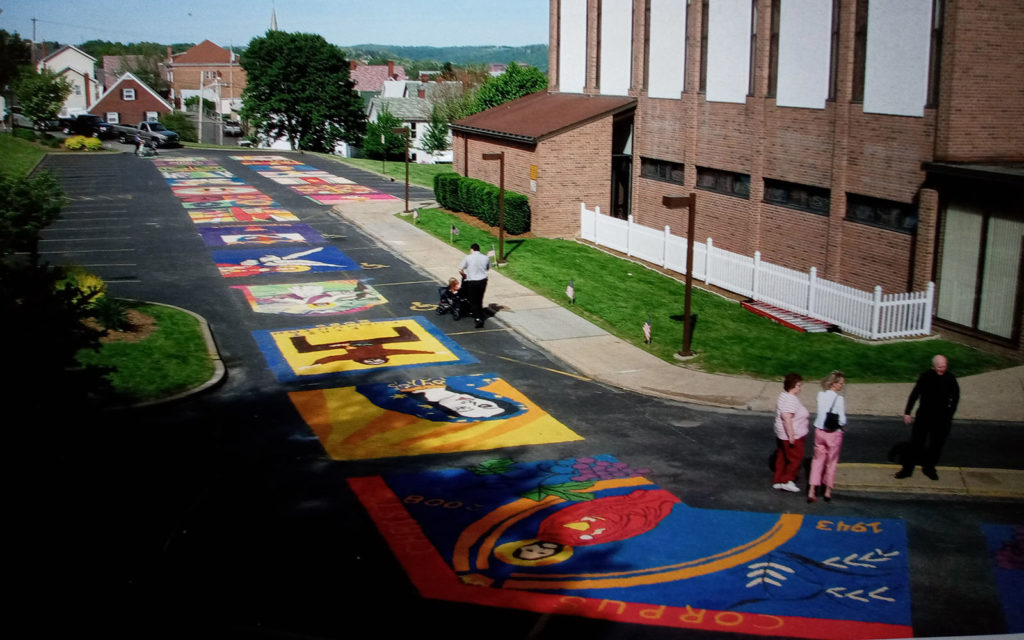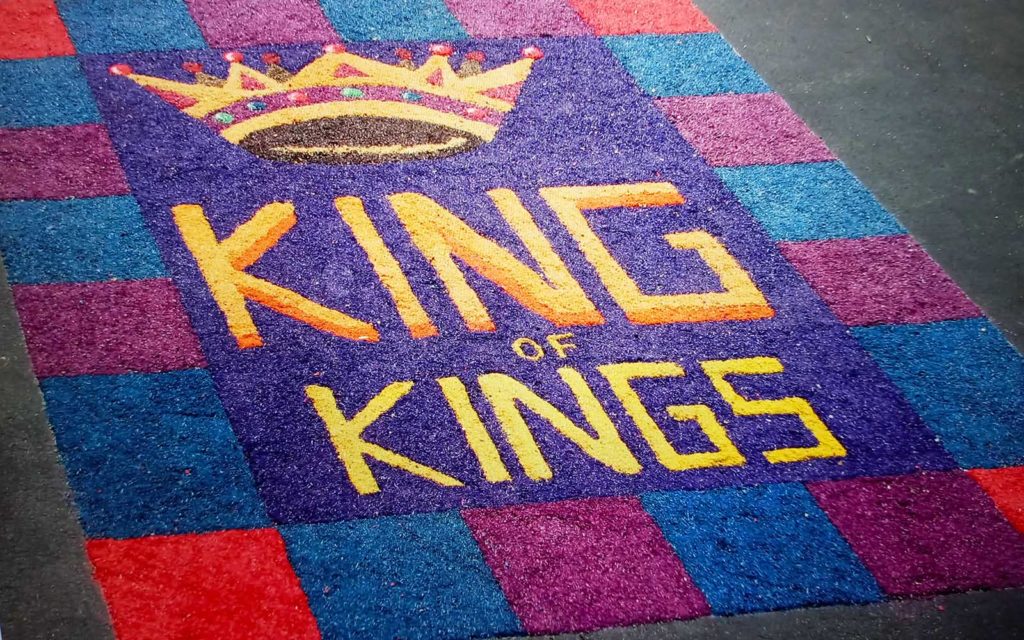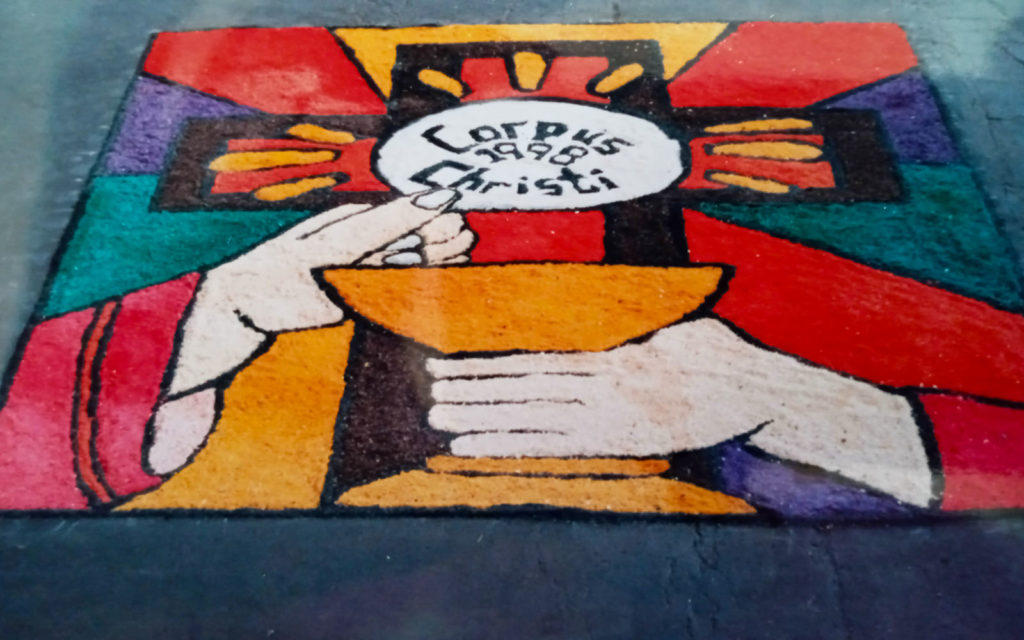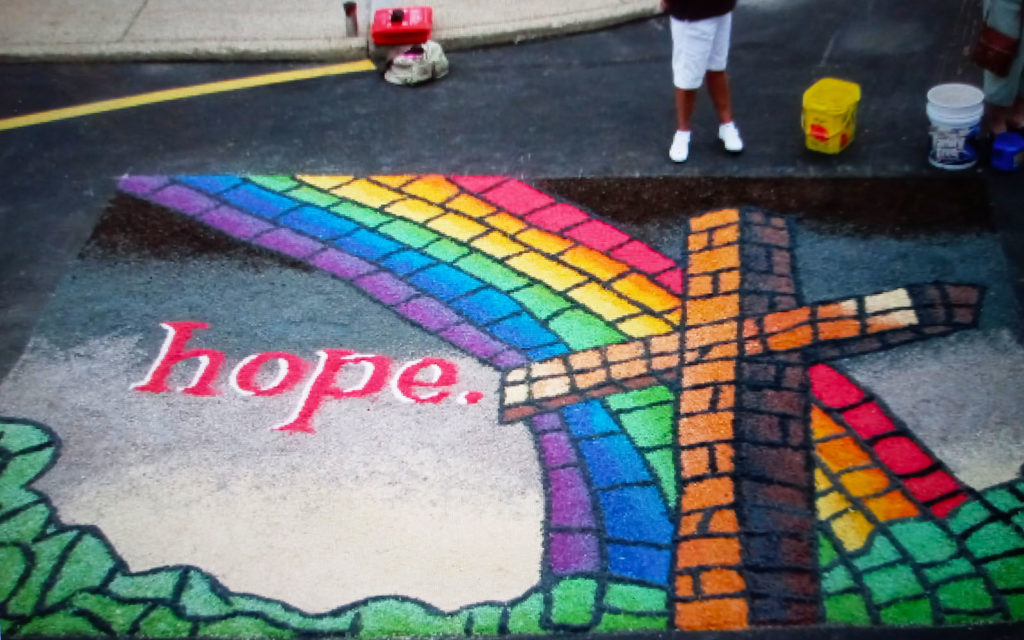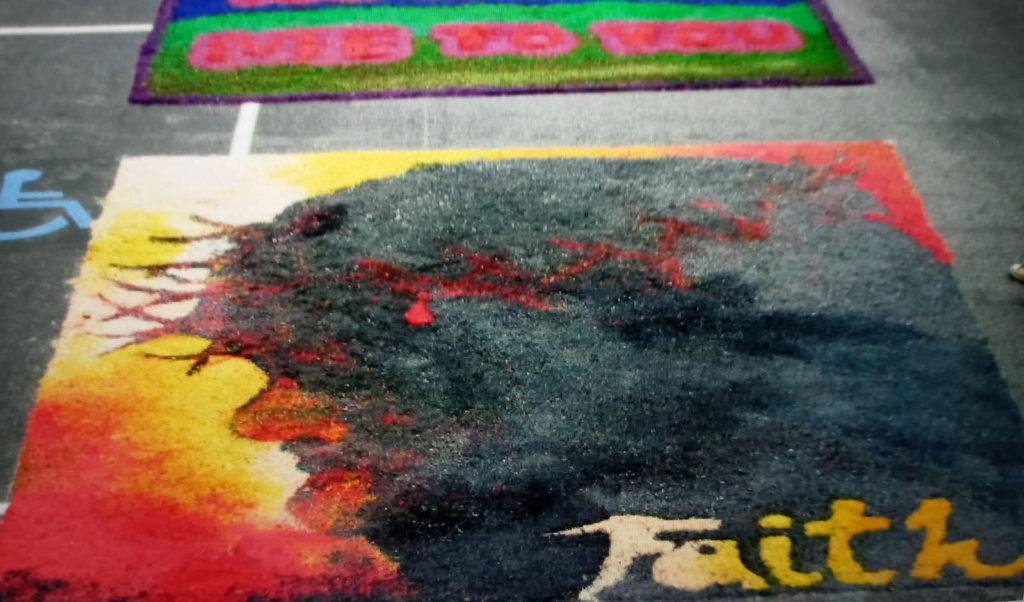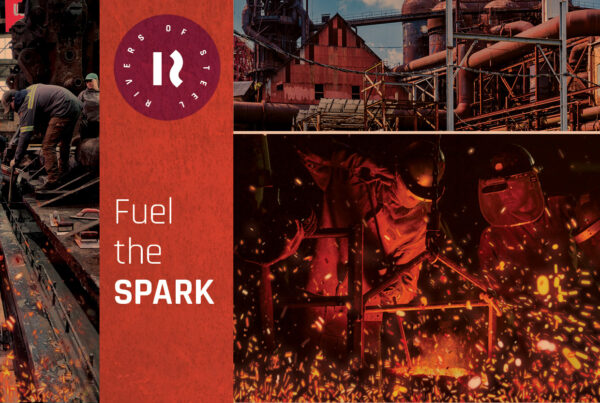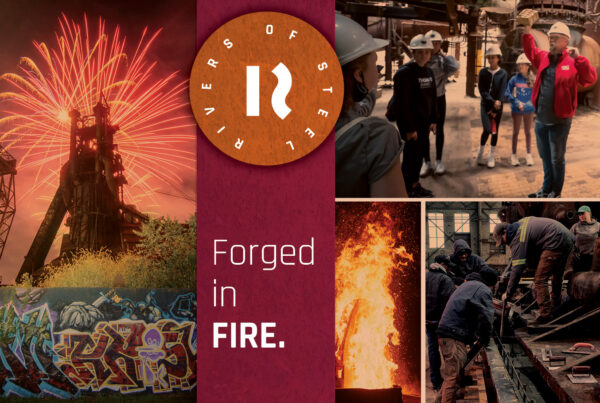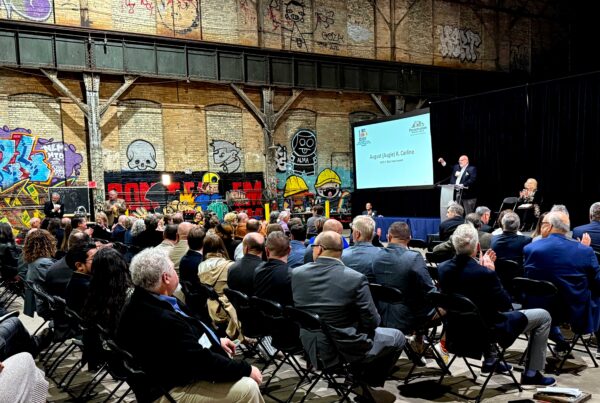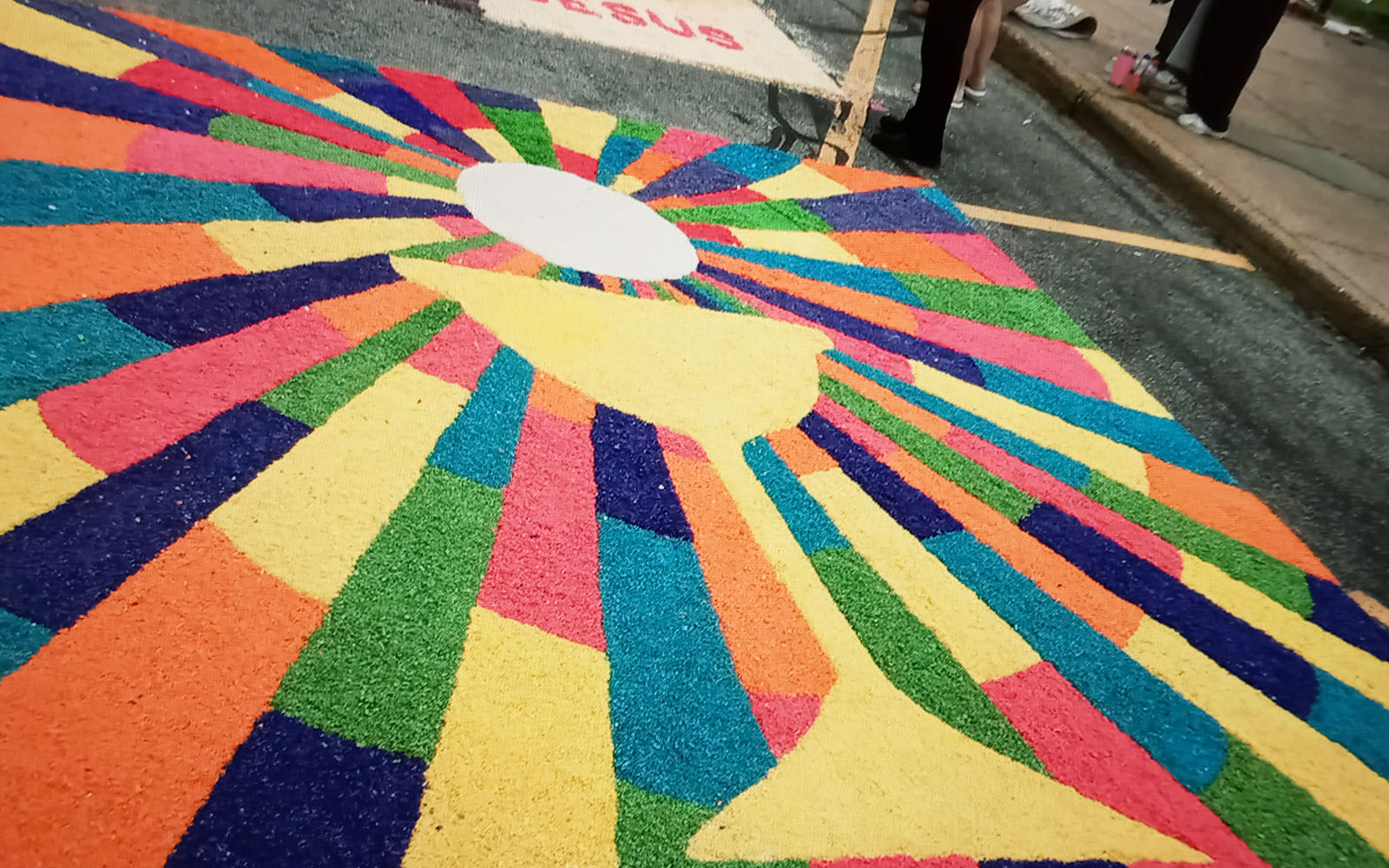
A sawdust carpet from the Feast of Corpus Christi at the Holy Martyrs Parish.
Heritage Highlights
Rivers of Steel’s Heritage Arts program strives to represent the region’s diverse cultural heritage, from ethnic customs and occupational traditions directly linked to Pittsburgh’s industrial past to new American folk arts and cultural practices emerging from the region’s diverse urban experience. Usually passed down from person to- person within close-knit communities, these cultural traditions are as varied as they are unique, each representing one aspect of what makes southwestern Pennsylvania’s heritage so rich.
For this month’s story, Heritage Arts Coordinator Jon Engel visited the borough of Tarentum, just 20 minutes up the Allegheny River from downtown Pittsburgh. Tarentum is host to Holy Martyrs Parish, a Catholic church with roots in the 19th-century industrial boom and the only church in America that carries on the tradition of creating sawdust carpets to mark religious events. He spoke with David Kuniak, a long-time participant in the tradition, who shared his philosophy on the carpets and the community they create.
Holy Martyrs’ Sawdust Carpets
By Jonathan Engel
The Sawdust Carpets of Corpus Christi
Like its many cousins in southwestern Pennsylvania, Tarentum is a small industrial town right on the river. It is carved, sometimes deftly and sometimes awkwardly, into the steep hillsides of the Alle-Kiski Valley. Early last month, I found myself walking up one of Tarentum’s slopes to Holy Martyrs Parish. There, I met David Kuniak, who laughed and complained about the hot afternoon he spent that weekend mowing the church’s lawn. David is a lifelong member of Holy Martyrs and an expert in one of this region’s singular artforms—the sawdust carpets of the Feast of Corpus Christi.
After the construction of railroads in 1866 and the opening of CL Flaccus’s glass factory in 1879, Tarentum’s population boomed with immigrant workers. In 1896, Catholic priests from the Holy Ghost Seminary established a new church for the borough’s large German community. It was called Sacred Heart. In 1969, as Tarentum’s population declined with its glass production, Sacred Heart was merged with a nearby Italian church called St. Peter’s. A new building was constructed in the same space, becoming Holy Martyrs Parish. It consists of two distinct flat lots about halfway up the hill that is West Tarentum and a modern church, with a prominent cross on its side and a grotto shrine dedicated to St. Mary up the hill from the entrance. David let me inside and the two of us sat together in the pews as we spoke about the carpets.
The story goes that, in 1943, a new priest arrived to lead the church. Like all his predecessors at Sacred Heart, Father James McNamara was trained at the Holy Ghost Seminary, which is located in the Black Forest mountain range in southwestern Germany. There, priests have been creating elaborate “sawdust carpets” for a variety of church events for centuries. These were temporary murals, the sawdust dyed various colors and assembled on the ground, often used in religious processionals. Similar traditions occur at other Catholic churches all around the world, such as the flower petal carpets constructed inside Arundel Cathedral in England and in the streets of Antigua, Guatemala during Lent. Holy Ghost’s specific practice developed around the white pines common to the Black Forest, the sawdust of which is incredibly good at absorbing water-based dyes. It is said that Father McNamara was so moved by these images that, when he came to Tarentum, he led his new parish in creating their own carpets and processional. They did so to mark the feast day of Corpus Christi, spawning an annual tradition.
That story is a little spotty. Tarentum historian Skip Culleiton has found footage of sawdust carpets at Holy Martyrs’ events as early as 1942 and testimonials from church members who recall making them years before Father McNamara moved in. “That’s sort of the mystery of the carpets,” David says, smiling, “Nobody actually knows how they started. The people who knew are dead.”
Each carpet lives for only one day, most of which is spent creating it. The process is long, meticulous, and hard. Participants must bend over concrete in the summer sun and patiently arrange sawdust, soil, and whatever else they choose to incorporate. But despite the labor and the ephemerality of its products, the practice has continued for nearly eight decades. It had never been rained out or delayed, until the pandemic forced them to cancel the event in 2020 and 2021. In 2020, the diocese combined Holy Martyrs with seven other churches to create Guardian Angels Parish, which is spread across several buildings. David hopes that the carpets will return next year bigger than ever with help from the new parishioners. This would continue a tradition he has helped maintain for most of his life.
David Kuniak, Steward of the Sawdust Carpets
Back in the ‘50s, the Corpus Christi celebrations were organized by a group called the Holy Name Society, which only allowed its all-male membership to participate in making the sawdust carpets. In 1972, an 18-year-old David Kuniak, fresh out of high school, was made chairman of the carpet committee. He had been making them since middle school, starting with small carpets on the sidewalk outside the old building.
“I wanted to do them because you weren’t allowed! When you were in 8th grade, at Sacred Hearts Church, kids could join in. It was something that you had to grow into and was obviously sacred to the older people, but it took forever to get to 8th grade. And when you can’t participate, for a little kid, that’s tough. When I took over, that ended right there.”
Immediately, David opened the process up to women, children, and even non-Catholics. These days, all sorts of people flock to Tarentum for the celebrations—worshippers, neighbors, and professional artists. It is common for families to make carpets together, passing the art from generation to generation as everyone gets involved at once. Some years, participants have created up to 30 individual carpets, all in the two-level parking lot beside Holy Martyrs. Though David passed the reins over many years ago—to his cousin Jim Huey—he remains heavily involved. It is a family tradition—his brother creates murals with his children every year, too. He speaks of previous works wistfully, musing to himself about how “absolutely gorgeous” the carpets he’s seen have been.
“People are coming from distances now to do them, to make them. Whenever I see somebody new, I always take the chance to sit down and talk to them. I stick their name and their phone number in my address book. If you’re here and you really like them, you can do them. Don’t stand there and say you’d like to do them. You’re welcome to do them, we want you to do them.”
He continues: “We had some kids who lived on West 10th Ave. here and they don’t go to church or whatever, but they would just be sitting up there on their porch and watching. They said to me one year, ‘Can we take some sawdust and go on the sidewalk and make our own carpet?’ and I said, ‘Instead of doing it off to the side, why don’t you do it here with us?’”
That attitude permeates all aspects of the process. Many different styles abound, from traditional religious scenes to abstract geometries to simple kids’ drawings. “Everybody has their own talents,” David explains, “What can you do? Some people draw, some people just like to fill them in. That’s a talent too, y’know, making the colors blend together. Your skill level doesn’t matter—God appreciates all skills.”
Likewise, the subject matters vary. The church asks that the carpets remain religious in some sense, but participants have expressed themselves not only in Biblical scenes but in various symbols, national flags, and portraits.
The Making of the Sawdust Carpets
The process has remained largely the same since it began with the Holy Name Society. Jim, David, and other church members dye the sawdust a week before the event, although they have shifted from seven natural dyes to a wide array of artificial colors. The dyes are mixed in with white pine sawdust, donated by a mill in the North Side, which is turned in cement mixers and left to dry in burlap sacks outside the church.
Work on the murals begins around 6:00 a.m. on the feast day. Many participants arrive earlier in the morning, sometimes even the night before, to sketch out their carpets on the cement. To do this, they use chalk donated by a local welding company. Since David took over in the ‘70s, Holy Martyrs has provided drawings on grids and stencils to make the design easier and help people nail difficult proportions. “A lot of people come in and say, ‘I want to make one, but I can’t draw’…no excuses!”
Participants sculpt their images by hand, piling sawdust on to their outlines and using combs to even it out. Several helpers move through the lot, spraying the carpets with a hose set to “mist”. The water holds the sawdust to the ground on windy days and pulls the colors out more vibrantly, allowing the delicate materials to last. At 4:00 p.m., work ends. Shortly after, the priests of Holy Martyrs lead a processional around the lot, weaving around the carpets up to their outdoor shrine. The carpets are left out for a few more hours for people to view until a street sweeper, borrowed from the Tarentum borough, comes by and clears them out.
“It’s hard to push a broom and clean them up once you’ve put all that work into it!” David laughs, “But also, we have them in the pictures and movies, so they’re never really gone. And their purpose was not for us to begin with. Other people, I’ve seen them in tears once you start sweeping them up.”
The Feast of Corpus Christi—Celebrating Love & Community
“See, I can’t draw.”
Instead, David typically creates large, tapestry-like prayers with a set of letter stencils he made years ago. “A lot of the priests would come around and say, why are you doing prayers all the time? I says, ‘well, for a number of reasons, Father. First one is, I went to a confession and that was my penance.’ But people, when you start making it, they start reading it. So by the time I’m done, every person has said a prayer.”
In David’s eyes, the carpets are offered up for God, and the act of creating them is an act of love. Even among non-Christian participants, he sees deep love in the effort they put in to create images for others to enjoy.
“Love, that’s the catch-all term for everybody who’s doing it. For a Catholic, that comes in the body and blood of Christ—that, here at the altar, bread, and water change into. That’s the Eucharist. That’s our belief.”
The Feast of Corpus Christi is dedicated to that belief. It is a holiday unique to Catholics and a small cluster of other Christian faiths. But, through the spontaneity and inclusivity of the sawdust carpets, that day has been opened up for the entire community to celebrate.
“I think that’s what God would want, too. He wants people to come together, He wants them to live together. People getting involved with other people. People caring about other people, and working with other people, and being happy with other people. How many things like that are there in life? You wanna’ be a professional baseball player? You can’t, you don’t have the skill level. We don’t care about skill level here. We want you, you as a person.”
The next Feast of Corpus Christi will occur on Thursday, June 16th, 2022 at Holy Martyrs Parish in Tarentum, Pennsylvania. Participation is open to all.
Citations
All images courtesy of David Kuniak.
Culleiton, Skip. Corpus Christi Carpets: Holy Martyrs Parish, Tarentum, PA. Creighton Printing Company, 2004.
“About Tarentum”. Tarentum Borough, tarentumboro.com. Accessed June 30, 2021.
McDonnell, Sharon. “The Flower Carpets of Antigua Presage Easter in Guatemala”. Garden Collage Magazine. 5 April 2017, gardencollage.com.
Read more in the Heritage Highlights series. Check out this story about artist Kathleen Ferri or this interview with members of Women of Visions.

